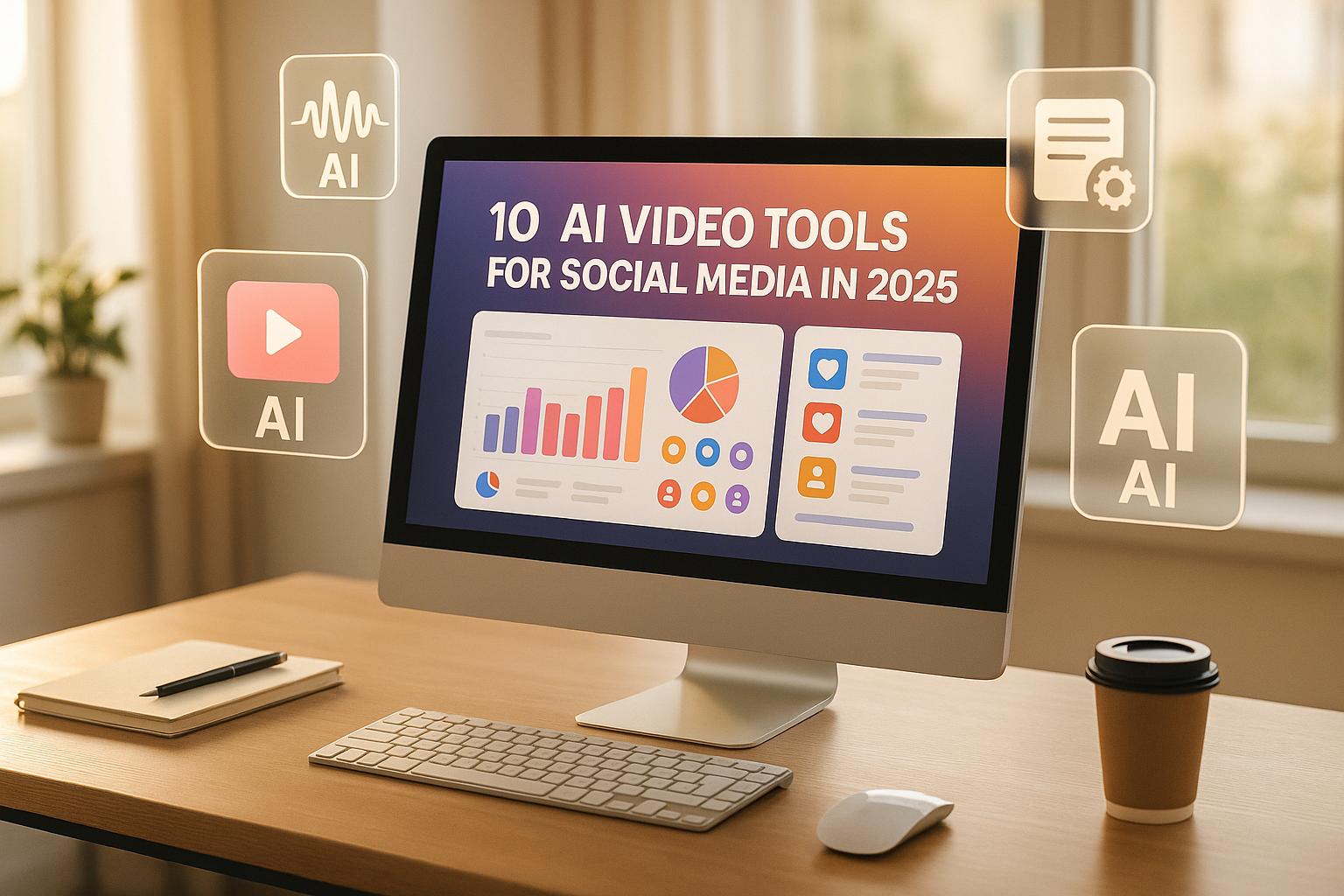AI is changing the way businesses attract customers by slashing costs and improving efficiency - without hiring more staff. Here's the big takeaway: Companies using AI tools for customer acquisition have reduced their Customer Acquisition Cost (CAC) by up to 50%. How? By automating tasks, improving targeting, and personalizing marketing at scale.
Key points:
- AI tools lower CAC by automating lead generation, qualification, and campaign management.
- Better targeting: AI identifies high-value prospects and optimizes ad spend on the best-performing channels.
- Personalized marketing: AI crafts tailored messages for individual customers, boosting engagement and conversions.
- Top tools: Platforms like Clari, Exceed.ai, People.ai, and Drift streamline processes and improve results.
The secret lies in replacing manual, time-consuming tasks with AI-powered solutions that make every dollar count. Businesses can analyze data, predict outcomes, and adjust strategies in real time - all while keeping their teams lean.
If you're looking to cut costs and grow smarter, AI is the way forward.
How Will AI Change Customer Acquisition Cost For Founders? - Founders Supporting Founders
AI Methods to Cut CAC Without Hiring More Staff
AI is transforming how companies approach customer acquisition costs (CAC), making it possible to achieve more with fewer resources. By automating processes, delivering tailored experiences at scale, and using data to make smarter decisions, businesses can significantly reduce expenses. For instance, companies leveraging AI for sales lead generation have seen a 50% boost in leads and a 60% drop in costs[1]. Let’s explore how automation, personalization, and smarter targeting are reshaping customer acquisition.
Automated Lead Generation and Qualification
AI takes the heavy lifting out of lead generation, turning what used to be a manual, time-consuming process into a seamless, automated system. Machine learning tools analyze vast datasets - like website interactions, content engagement, company growth trends, and social media activity - to pinpoint high-value prospects with strong conversion potential[1].
Predictive lead scoring is another game-changer. It assigns scores to leads based on their likelihood to convert, helping sales teams prioritize their efforts. This approach has been shown to boost sales close rates by 20%[1]. Salesforce also reports that AI-driven lead scoring can cut sales cycles by 30% and increase deal closure rates by 25%[3].
AI-powered chatbots add another layer of efficiency by engaging visitors in real time. They ask targeted questions, gather critical data, and even schedule meetings automatically. These conversational tools not only prevent leads from slipping through the cracks but also reduce CAC by up to 30% while enhancing conversion quality[3].
Beyond initial contact, AI handles more complex tasks like researching accounts, identifying decision-makers, and creating personalized outreach campaigns across channels like email, LinkedIn, and phone calls[4]. Automated tools also keep lead profiles accurate by updating them with detailed firmographic, technographic, and behavioral data[4].
Better Personalization with AI Data Analysis
Personalization is no longer a luxury - it’s an expectation. AI makes it possible to deliver highly customized experiences at scale by analyzing individual behaviors, preferences, and engagement histories. This means emails, product recommendations, and landing pages can all be tailored in real time. Unsurprisingly, 80% of marketers using AI-driven personalization report better customer engagement[1].
AI-powered CRM systems take this further by automating lead management and sales tasks like follow-ups and meeting scheduling. They also provide predictive insights to help close deals and forecast revenue[5]. These tools save sales teams 60–80% of the time they would otherwise spend on manual data processing, while predictive analytics can enhance sales productivity by up to 40%[1][2]. With AI fueling personalization, every marketing dollar works harder.
Smarter Campaign Targeting with AI
AI is revolutionizing campaign targeting by analyzing customer behavior and performance data to identify the most effective strategies and channels. Instead of spreading budgets thinly across multiple platforms, AI pinpoints where your ideal customers are and how they prefer to engage. Lookalike modeling further refines this process by identifying prospects who closely match your best-performing customers.
Real-time monitoring allows AI to adjust campaign targeting and ad bids instantly, optimizing performance on the fly. This dynamic approach can cut CAC by 20–35%[2]. AI also enables advanced audience segmentation, breaking down audiences into micro-segments based on their behavior and engagement patterns. This precise targeting leads to a 30–50% improvement in campaign management efficiency overall[2].
Best AI Tools to Lower CAC in SaaS and Digital Markets
The right AI tools can slash your customer acquisition costs (CAC) by up to 50% [7]. With 90% of leading businesses now using AI to enhance customer interactions and boost retention [8], the real question isn’t whether to use AI - it’s which tools will make the biggest difference for your business. Below, we’ve outlined some of the top AI tools that can help you achieve those results.
Top AI Tools for Customer Acquisition
Clari is a revenue operations platform designed to predict deal outcomes and refine sales processes. It analyzes communication patterns, meeting frequency, and engagement metrics to forecast which deals are most likely to close. This allows sales teams to focus their efforts on high-probability prospects, cutting down wasted time and improving efficiency.
Exceed.ai specializes in conversational lead engagement. Its AI-powered assistants handle initial prospect interactions, qualify leads, and even schedule meetings automatically. By engaging prospects right after their first contact, Exceed.ai keeps leads warm and ensures they move through the sales funnel without delay - no extra staff needed.
People.ai captures and analyzes sales activities from emails, calendars, and CRM systems to generate actionable insights. By identifying the behaviors that lead to successful deals, it helps sales teams replicate winning strategies and improve overall performance.
Drift transforms website engagement with AI-driven chatbots that qualify visitors in real time. These bots answer common questions, engage prospects, and route qualified leads to sales reps. Drift not only improves lead qualification but can also cut customer service costs by up to 30% [8].
With 86% of companies using AI-driven recommendations reporting a reduction in CAC [9], these tools are game-changers for businesses looking to optimize their customer acquisition strategies.
Finding AI Solutions with Top SaaS & AI Tools Directory
The Top SaaS & AI Tools Directory is a go-to resource for discovering AI-powered solutions that can significantly reduce your CAC. Instead of spending hours researching, this directory provides curated tools for lead generation, sales optimization, and marketing automation - all in one place.
A major advantage? It addresses one of the biggest challenges businesses face: data bottlenecks. With 61% of marketing leaders blaming data issues for failed campaigns [9], this directory connects you with tools that unify customer data and enable real-time engagement. This eliminates fragmented approaches and ensures you’re selecting tools that genuinely improve your CAC.
The directory also goes beyond just listing tools. It offers practical insights into how each solution integrates with your workflows and delivers measurable results. Plus, you’ll gain access to exclusive training on maximizing the impact of AI and SaaS tools, helping you get the most out of your investment.
AI Tools Comparison Chart
Here’s a quick look at how these AI tools contribute to lowering CAC:
| Tool | Primary Function | Key Automation Features | Impact on CAC |
|---|---|---|---|
| Clari | Revenue Operations | Predictive deal analysis and pipeline management | Improves sales focus through smarter prioritization |
| Exceed.ai | Lead Engagement | Conversational lead qualification and meeting scheduling | Speeds up lead conversion with timely responses |
| People.ai | Sales Analytics | Activity tracking and performance insights | Boosts sales efficiency by optimizing activities |
| Drift | Website Conversion | Real-time chat and visitor qualification | Enhances engagement and cuts support costs |
These tools don’t just help you acquire customers more effectively - they also recover lost opportunities. For example, 84% of companies using AI tools report successfully reclaiming lost conversions from cart abandonment [9].
Businesses leveraging advanced lead targeting through these AI platforms have seen a 34% drop in CAC and a 27% increase in conversion rates [6]. The secret lies in choosing the tools that address your specific pain points, whether it’s improving lead qualification, optimizing campaigns, or automating sales processes.
sbb-itb-9cd970b
Case Studies: Companies That Cut CAC with AI
Here are two examples of how businesses have successfully used AI to reduce Customer Acquisition Costs (CAC) through smarter segmentation and lead qualification.
SaaS Startup Streamlines CAC with AI Segmentation
A project management SaaS startup was struggling with high CAC due to manual segmentation and one-size-fits-all messaging. By adopting AI-driven segmentation and predictive analytics, the company tapped into its customer data to create more targeted segments and personalized messaging. This shift not only lowered CAC but also boosted conversion rates - all without increasing team size. It’s a clear example of how AI can replace time-consuming manual processes with smarter, more efficient solutions.
E-Commerce Business Slashes CAC via Automated Lead Qualification
An online retailer specializing in professional audio equipment faced similar CAC challenges, largely due to inefficient lead qualification. To tackle this, they introduced an AI-powered system to handle initial customer interactions and automate lead scoring. By analyzing visitor behavior and identifying high-intent prospects, the system reduced CAC, increased lead-to-customer conversion rates, and filtered out low-value inquiries. This approach highlights how AI can streamline processes and focus efforts on the most promising opportunities.
These examples show that AI in customer acquisition isn't just about cutting costs - it’s about working more effectively. By automating complex, labor-intensive tasks like segmentation and lead qualification, businesses can redirect their energy toward strategic goals and building stronger customer relationships, all while driving growth without expanding their workforce.
Step-by-Step Guide to Reduce CAC with AI
Using AI to reduce your customer acquisition cost (CAC) can be a game-changer, but it requires a structured approach. Start by evaluating your current processes, select the right tools, and continually refine your strategy based on real-world data.
Analyze Your Current CAC and Processes
Before jumping into AI solutions, take a close look at where your money is going and identify the areas draining resources. Calculate your CAC by channel and segment, and break it down into metrics like cost per lead, conversion rates, and time spent on manual tasks.
Pinpoint inefficiencies - things like manually scoring leads, sending out generic follow-up emails, or spending hours researching prospects. These repetitive tasks are perfect for AI automation. Also, check the quality of your data; poor data can lead to wasted effort and misdirected spending. Document these inefficiencies to help guide your choice of AI tools.
Set up a baseline system to track key performance indicators (KPIs) such as cost per qualified lead, sales cycle length, and channel-specific conversion rates. This baseline will be your benchmark for measuring the success of your AI implementation.
Choose and Set Up the Right AI Tools
The key to selecting the right AI tools is to start with clear, specific goals. Focus on one or two objectives - like improving lead qualification or personalizing email campaigns - and choose tools that fit your budget and meet your customer needs.
When evaluating AI vendors, look at their expertise, privacy policies, pricing, customer support quality, and how quickly you can expect results. Make sure the tools integrate smoothly with your existing systems. Keep in mind that deployment speed can be a sticking point, so consider starting with a pilot program focusing on a single use case to reduce risk and simplify the transition.
Data quality is critical. Clean up your customer database and standardize how you collect data before implementing AI. This ensures the system is working with reliable, accurate information from the very beginning.
Once you’ve set up the tools, the next step is to track performance and refine your approach.
Track Results and Scale Your AI Strategy
Set up a system to monitor performance against your baseline metrics. Don’t just track the overall reduction in CAC - keep an eye on leading indicators like lead quality, email open rates, and sales team productivity. Regular reviews will help you see what’s working and where tweaks are needed. Remember, while AI systems improve as they process more data, they still need human oversight.
Use real-time data to fine-tune your strategy. Experiment with different messaging, adjust targeting parameters, and test new automation workflows based on your performance insights. Once you start seeing positive results, gradually expand your AI applications to other channels or customer segments. For example, if AI-powered email personalization works well for your existing customers, extend it to prospect outreach. Similarly, if automated lead scoring is successful in one market, roll it out to others.
Maintain regular communication between your sales and marketing teams. Their insights can highlight details that raw data might miss, helping you further refine your AI algorithms and improve campaign targeting. The goal isn’t to replace human judgment but to free your team from repetitive, time-consuming tasks. This allows them to focus on strategic initiatives and building stronger customer relationships, all while AI handles the heavy lifting. By following this disciplined approach, AI can help you acquire customers more cost-effectively while keeping your operations lean.
Conclusion: Growing Your Business with AI Customer Acquisition
Imagine cutting your customer acquisition costs by 50% without needing to expand your team. Businesses using AI-powered tools have already turned this into a reality. The secret? AI doesn’t replace human expertise - it enhances it, helping your team work smarter, not harder.
Key Takeaways
AI reshapes customer acquisition by excelling in three main areas: automated lead generation and qualification, personalized experiences powered by data, and precision-targeted campaigns. Together, these capabilities eliminate time-consuming manual tasks that often inflate costs and slow progress.
To get started, measure your current customer acquisition cost (CAC). This step helps identify inefficiencies and highlights where AI can make the biggest difference. Whether it's streamlining lead scoring, scaling personalized email campaigns, or using predictive analytics to refine ad spend, the goal is simple: reduce effort while maximizing results.
One critical factor for success is data quality. Clean, standardized customer data is the backbone of effective AI systems. Without it, even the best tools can fall short.
Companies seeing the best outcomes take a measured approach. They begin with pilot programs focused on specific tasks, track results, and expand their efforts as they gain confidence. This strategy minimizes risks and allows teams to build expertise gradually.
Starting Your AI Journey
You don’t need a massive budget or a full system overhaul to begin leveraging AI. Start small by targeting areas where manual work consumes too much time or money - like lead qualification, campaign optimization, or email personalization.
The Top SaaS & AI Tools Directory is a great resource for finding solutions tailored to your business needs. Focus on tools that integrate seamlessly with your current systems and address your most pressing challenges.
Once you’ve selected a tool, launch a 30 to 60-day pilot program. Choose a specific customer segment or marketing channel to test, and track key metrics like email open rates, lead conversion efficiency, and CAC. This approach minimizes disruption while providing valuable insights.
AI systems improve over time as they process more data and learn from customer behavior. Businesses achieving 40-50% CAC reductions often see gradual progress over 3-6 months. Consistency and patience are key to unlocking AI’s full potential.
Finally, don’t overlook the value of your team’s expertise. Use their insights to fine-tune AI algorithms, ensuring your campaigns hit the mark. By blending human creativity with AI-driven efficiency, you can achieve sustainable growth without increasing headcount. It’s all about creating a partnership that drives smarter, scalable results.
FAQs
How can AI-powered tools help reduce Customer Acquisition Costs (CAC) by up to 50% without increasing team size?
AI-driven tools play a key role in lowering Customer Acquisition Costs (CAC) by using real-time data analysis to craft highly personalized marketing campaigns. This approach not only increases conversion rates but also reduces wasted ad spend, making every dollar count. These tools take over tasks like lead generation and customer targeting, automating processes that save time, cut down operational expenses, and improve overall efficiency.
By simplifying workflows and reducing the need to hire additional staff, businesses can expand their customer acquisition strategies without inflating costs. This blend of automation, accuracy, and streamlined operations allows companies to significantly reduce CAC while maintaining strong performance.
What are some AI tools that can help reduce customer acquisition costs by automating lead generation and improving campaign targeting?
AI tools such as Persana AI, Smartwriter AI, and Exceed AI are game-changers when it comes to automating lead generation. They can pinpoint top-tier prospects and simplify outreach efforts, all thanks to their advanced algorithms. This not only saves time but also improves the quality of leads, helping businesses cut down on customer acquisition costs.
On top of that, platforms like SuperAGI and Salesmate.io take campaign targeting to the next level. By analyzing customer behavior and refining marketing strategies, these tools help businesses achieve better outcomes without needing to expand their teams. The result? A more efficient and scalable approach to acquiring new customers.
How can businesses ensure their data is high-quality for successful AI-driven customer acquisition?
To make AI work effectively in customer acquisition, businesses need to focus on data quality above all else. This means putting solid data governance practices in place, ensuring the information is accurate, and steering clear of relying solely on large amounts of data. Regular audits and validation processes are essential to keep data clean, dependable, and usable. By prioritizing quality over quantity, companies can refine their customer targeting, run campaigns more efficiently, and make smarter decisions - bringing their AI strategies to the next level.



